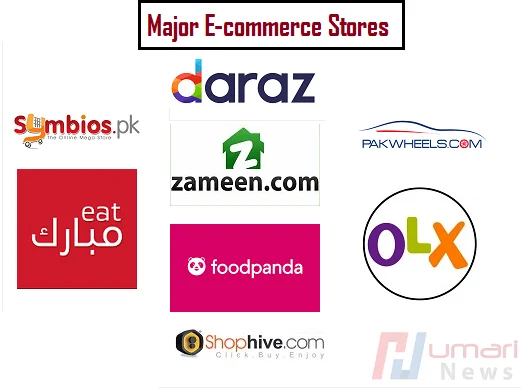Let us go back 40 years in time. A poor person from a village wants to sell handmade pots. Every day, he loads his bicycle with as many pots as possible. He pedals to the city each day. The city is 31 km away from his mud-brick house. Every single day, the old man hopes to sell as many pots as possible. The remaining pots are then paddled back to the house.
The process repeats itself the next day. Fast forward to the present day.
The old man’s youngest son is also a seller. But not like his father.
The son sells everything online using Daraz.pk. He does not need to pedal 31 km every day. Nor does he need to pray that all the products are sold before sunset. Instead, the son does not worry about any such things. He is simply indulged in his laptop and smartphone.
He waits patiently to receive the next order. The old man fails to understand any of this. He asks his son why he does not get out of the house? After all, it is what he did to make a living. Nor does he understand how his son earns money. Especially, when he hardly does except stare at the laptop screen.
Age of E-Commerce
The poor old man fails to realize that it is the Age of E-commerce. The son does not need to do anything that his father did. He must only replicate his father’s hard work. E-commerce has made it a lot easier to sell products and services. Likewise, it is equally easier to buy these products & services.
While other things are on a downward spiral, online businesses & ecommerce in Pakistan continues to grow each year.
But before I discuss current state of e-commerce in Pakistan, we need to know the history.
History of E-Commerce in Pakistan
E-commerce & internet availability go hand in hand. For several reasons, the internet is not available throughout Pakistan (this holds true even to this day). The first glimpses of e-commerce in Pakistan can be traced back to 2001. One of the first online stores in Pakistan was Beliscity (no longer functional in Pakistan).
Over the years, Shophive and Symbios made their mark. Another prominent name is HomeShopping.
[expander_maker id=”1″ more=”Read more”]
A Few Notable E-Commerce Initiatives
But now, we have Daraz, Azmalo and Foodpanda. Azmalo was renamed to Kaymu. Later, Daraz acquired it. Now, if you search Kaymu.pk on Google, it will automatically redirect you to daraz.pk. Daraz, at the time, was not the Daraz we know today. Instead, it was focused on fashion alone.
It is only about four years ago that it became the Daraz we have come to rely on heavily today. Apart from these, other notable names in the e-commerce market are OLX, Zameen.com and Rozee.pk. Although the latter two are not your typical e-commerce marketplaces, they do deserve mention.

Problems of E-Commerce in Pakistan
Pakistan has witnessed a host of e-commerce platforms over the years. But they have failed to achieve success. For instance, no Pakistani store can be compared to India’s Flipkart.
The failure can be attributed to various reasons.
One reason is the non-availability of a reliable payment network. PayPal is not available in Pakistan despite the best efforts of the Government. Nevertheless, cash on delivery, Easypaisa, and Jazz Cash are a few alternatives. However, the non-availability of PayPal & similar payment systems prevent the growth of ecommerce in Pakistan.
Reasons for Lack of Success of Ecommerce in Pakistan?
Furthermore, lack of internet availability & other factors also contribute to Pakistan’s low e-commerce readiness score. Pakistan ranks above Myanmar and Afghanistan in this score.
However, the margin is quite low.

Internet availability to the population is also low in Pakistan. The below table shows internet availability in different Asian countries.

But the launch of 3G and 4G services are likely to increase internet penetration in Pakistan.
Nevertheless, opportunities of e-commerce in Pakistan continue to grow each year. It is worth mentioning that Chinese Alibaba Group now owns Daraz. Also, this acquisition showcases Pakistan’s true e-commerce potential.
Let us now consider what the e-commerce market looked like in 2018.
E-commerce in Pakistan in 2018
According to a State Bank of Pakistan’s (SBP) report of 2018, e-commerce retailers and payments have risen significantly over the years. The SBP values Pakistan’s e-commerce market at Rs. 99.3 billion. In 2017, the SBP valued it Rs. 51.8 billion. As a matter of fact, it does not reflect the true value of the market. The reason is that the SBP tracks the transactions done through the banks.
However, in Pakistan, most of the transactions take place through non-banking channels. These include cash on delivery method. The SBP does not track these transactions. Moreover, the figures are not surprising considering Pakistan’s true e-commerce potential. Another welcoming sign is the growth of internet availability.
Around 73% of Pakistan’s population (153 million) has access to mobile phones. Out of the 153 million, 61 million have access to 3G/4G services. It is surprising. Because these services are only available in select areas. Also, as the coverage area grows, so will the size of the online shopping market.
Entry of Alipay
Furthermore, another good news for the online businesses is Alipay. It acquired a 45% stake in the Telenor Microfinance Bank. This acquisition is increases the likelihood of a PayPal type a secure online payment mechanism. It is the need of the hour for e-commerce in Pakistan.
E-Commerce in Pakistan in 2019
‘How much e-commerce is effective in Pakistan?’.
It is a question that sounds absurd. No doubt that Pakistan has its fair share of challenges. There are no effective laws on consumer protection, privacy, data protection, online fraud. Even e-commerce related legislation is lacking. The e-commerce community (buyers and sellers) stand to benefit greatly from these legislation. It will increase the trust between the two and increase commercial activity. Despite it, Pakistan’s e-commerce market is booming.
E-Commerce Market to Reach $ 1 Billion
Apart from this, according to reports, the online market is to reach $ 1 billion by 2020. The successful testing of 5G by Zong will further increase internet availability among consumers. In turn, it will increase online commercial activity. However, one of the noteworthy challenges to Pakistan’s e-commerce market is the availability of digital finance.
Although the entry of Alipay is a much-needed boost, more needs to be done. According to the McKinsey Global Institute September 2016 Report, Pakistan can increase its GDP by 7 per cent. It is achievable by encouraging and developing digital finance. With government support and initiatives from the private sector, these challenges can be overcome.
Apart from this, another welcoming sign is the Government’s continued interest in it. The Ministry of Commerce made a draft e-commerce policy framework as well. When the policy is adopted by the government, surely e-commerce will be further streamlined.
Final Thoughts on E-Commerce in Pakistan
Growing interest of Chinese e-commerce & tech giants in Pakistan is a major sign that e-commerce in Pakistan is effective. Pakistan can realize its true e-commerce potential in the coming years. But it is only possible by effectively dealing with the issues of the e-commerce market. Moreover, Pakistan must encourage more investors to invest in this sector.
©Copyright Humari News.
[/expander_maker]








3 Comments